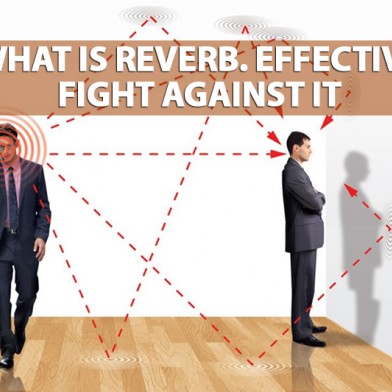Your shopping cart is empty!
What is reverb. Effective fight against it
- 01 November 2018 14:45:57
- Reviews: 0
- Views: 14923
-

What is reverb
 Reverberation is the process of reducing the intensity of sound when it is repeatedly reflected from surrounding surfaces. The main numerical characteristic of this process is the reverberation time, or how long it takes for us to stop hearing the echo. The reverberation time is the duration of the after-sound of the signal. In other words, this is the duration of the sound signal after turning off its source. The reverberation time depends on many factors: the size of the room, the materials of the room surfaces, the number of people in the room (people are the source of sound absorption), the presence and amount of furniture in the room, etc.
Reverberation is the process of reducing the intensity of sound when it is repeatedly reflected from surrounding surfaces. The main numerical characteristic of this process is the reverberation time, or how long it takes for us to stop hearing the echo. The reverberation time is the duration of the after-sound of the signal. In other words, this is the duration of the sound signal after turning off its source. The reverberation time depends on many factors: the size of the room, the materials of the room surfaces, the number of people in the room (people are the source of sound absorption), the presence and amount of furniture in the room, etc.Methods for reducing reverberation, or how to remove echo
 Each material has its own absorption coefficient - a parameter that depends on frequency and characterizes the efficiency of sound signal absorption. It is often hardest to deal with increased reverberation at low frequencies, because the sound at high frequencies is better attenuated in space. To combat reverberation at low frequencies, gypsum sheathing boards are well suited - they absorb sound well at low frequencies, but hardly absorb sound at high frequencies, which also leads to acoustic defects in the room.
Each material has its own absorption coefficient - a parameter that depends on frequency and characterizes the efficiency of sound signal absorption. It is often hardest to deal with increased reverberation at low frequencies, because the sound at high frequencies is better attenuated in space. To combat reverberation at low frequencies, gypsum sheathing boards are well suited - they absorb sound well at low frequencies, but hardly absorb sound at high frequencies, which also leads to acoustic defects in the room. Carpets are more balanced in this regard. A carpet with a 1 cm pile, unlike gypsum sheathing sheets, absorbs less sound at low frequencies, but absorbs sound better at medium and high frequencies. Furniture is less effective at absorbing echoes and has an order of magnitude lower absorption coefficient than acoustic panels and carpets. The main effect of echo absorption is provided by various sound-absorbing materials attached to the surfaces of the room. The most effective are acoustic panels made of various kinds of materials. They serve as excellent sound absorbers and can be used in any room.
Carpets are more balanced in this regard. A carpet with a 1 cm pile, unlike gypsum sheathing sheets, absorbs less sound at low frequencies, but absorbs sound better at medium and high frequencies. Furniture is less effective at absorbing echoes and has an order of magnitude lower absorption coefficient than acoustic panels and carpets. The main effect of echo absorption is provided by various sound-absorbing materials attached to the surfaces of the room. The most effective are acoustic panels made of various kinds of materials. They serve as excellent sound absorbers and can be used in any room. The most professional solution to echo problems are special acoustic panels of various shapes. For example - acoustic panels Tetras Acoustic or acoustic foam
The most professional solution to echo problems are special acoustic panels of various shapes. For example - acoustic panels Tetras Acoustic or acoustic foam
Their advantages:
- higher absorption coefficient than carpets,
- more modern look
- the best hygienic indicators.



